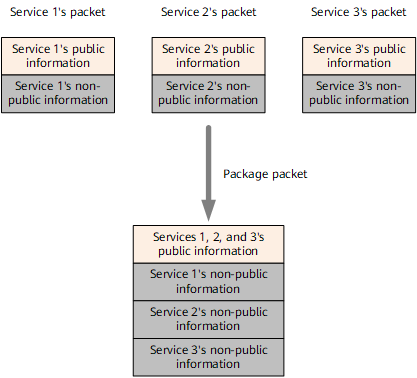EDSG Service Accounting
Accounting Modes
Start accounting: After a service is activated and a forwarding channel is established, start accounting is immediately triggered for the service.
Stop accounting: After a service is deactivated and a forwarding channel is deleted, stop accounting is immediately triggered for the service.
Real-time accounting: To ensure the timeliness and accuracy of user service accounting, the BRAS can send service accounting packets to the AAA server at a configurable interval.
Accounting start request packets, accounting stop request packets, and real-time accounting request packets carry information, such as the service name, Acct-Session-Id (44) attribute, service traffic volume, and service duration. In addition, the Acct-Multi-Session-Id (50) attribute is used to deliver the user accounting ID.
In non-uniform accounting mode, accounting is performed for all services, a service accounting packet is separately sent for each service of a user, and all services' traffic is independently counted. EDSG services support only non-uniform accounting (also called individual accounting).
EDSG service switching supports only the transmission of accounting stop packets for the original service and of accounting start packets for a new service.
Statistical Modes
User and service traffic supports the following statistical modes:
Statistics separation: Service traffic is not counted into user traffic. That is, user traffic statistics include only basic traffic except EDSG service traffic.
 Statistics separation for EDSG services does not support multi-VS scenarios.
Statistics separation for EDSG services does not support multi-VS scenarios.Statistics unseparation: Service traffic is counted into user traffic. That is, user traffic statistics include both basic traffic and EDSG service traffic.
- Rate limit separation: EDSG service traffic is unlimited by the basic user bandwidth. That is, EDSG service traffic does not use the basic user bandwidth.
- Rate limit unseparation: EDSG service traffic is limited by the basic user bandwidth. That is, EDSG service traffic uses the basic user bandwidth.
Accounting Copy
- Copy of EDSG service accounting packets: When sending an EDSG service accounting packet to the AAA server, the NetEngine 8000 F copies the packet to the accounting copy server.
- Copy of EDSG prepaid accounting packets: When sending an EDSG prepaid accounting packet to the AAA server, the NetEngine 8000 F copies the packet to the accounting copy server.
EDSG accounting copy supports accounting start, real-time accounting, and accounting stop. If accounting packets fail to be copied to the accounting copy server, EDSG service activation is not affected.
Accounting Packaging
EDSG enables the NetEngine 8000 F to package a user's EDSG service accounting packets into a packet and send the packet to the RADIUS server. By default, EDSG service accounting packets are independently sent and are not packaged. This function can be implemented through configuration.
- Real-time accounting packets of EDSG services
- Prepaid real-time accounting packets of EDSG services
- Accounting stop packets of EDSG services when users go offline
- Prepaid accounting stop packets of EDSG services when users go offline
